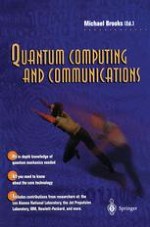1999 | OriginalPaper | Buchkapitel
Quantum Networks and Quantum Algorithms
verfasst von : Vlatko Vedral
Erschienen in: Quantum Computing and Communications
Verlag: Springer London
Enthalten in: Professional Book Archive
Aktivieren Sie unsere intelligente Suche, um passende Fachinhalte oder Patente zu finden.
Wählen Sie Textabschnitte aus um mit Künstlicher Intelligenz passenden Patente zu finden. powered by
Markieren Sie Textabschnitte, um KI-gestützt weitere passende Inhalte zu finden. powered by
I plan to explain how to do simple arithmetic operations, and then I want to demonstrate a simple example where we can easily see why quantum computing is more efficient than its classical counterpart. Just to remind you about looking at gates, Figure 12.1 is a simple network that accomplishes addition. Now this cannot be done on a quantum computer in this way, and there’s an easy way to see why that is true. Take the first gate as an example: we don’t even need to know what the gate does, what we need to see is that there are two inputs and one output. Therefore quantum information is lost on its way through the gate, and so this cannot be done reversibly. Since quantum computation is governed by unitary transformations, you need to do this reversibly. You simply would not be able to implement the first gate in Figure 12.1 on a quantum computer. The rule of thumb for doing this reversibly is that one has as many qubits coming into the gate as there are coming out of the gate. Let’s look at a very simple example: addends in this case.
